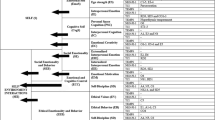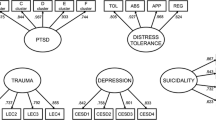Abstract
Objectives
The main goal of the research was to assess temperamental determinants of trauma symptoms in firemen, policemen and soldiers. The temperament traits which were considered were those postulated by the Regulative Theory of Temperament (briskness, perseveration, sensory sensitivity, emotional reactivity, endurance and activity).
Material and Methods
A cross-sectional study was run on non-clinical samples. The participants were 417 men, White-Caucasian only: 284 firemen (aged 21–55), 58 policemen (aged 22–45), and 75 soldiers (aged 21–42). Temperament was assessed using the Formal Characteristics of Behavior — Temperament Inventory. Intensity of trauma symptoms was assessed with the PTSD-Factorial Version Inventory, a quantitative measure of trauma-related symptoms. The respondents were examined in their place of work. The study included only men reporting at least 1 traumatic event during the year before the trauma diagnosis.
Results
Emotional reactivity had a significant positive effect on the intensity of trauma symptoms only in the group of firemen. Emotional reactivity accounted for 16% of the variance of trauma intensity symptoms in this occupational group. Negative significant effect on trauma symptoms was found for briskness only in the soldiers group (briskness explained 20% trauma intensity variance in this group).
Conclusions
Emotional reactivity was conducive to the increased trauma symptoms intensity in firemen, whereas briskness tended to reduce symptoms intensity only in the group of soldiers.
Similar content being viewed by others
References
Adler AB, Keane TM, Bliese PD. Measurement of posttraumatic stress disorder in an occupational health context. In: Sinclair RR, Wang M, Tetrick LE, editors. Research methods in occupational health psychology: Measurement, design, and data analysis. New York: Routledge/Taylor & Francis Group; 2013. p. 122–137.
Corneil W, Beaton R, Murphy S, Johnson C, Pike K. Exposure to traumatic incidents and prevalence of posttraumatic stress symptomatology in urban firefighters in two countries. J Occup Health Psychol. 1999;4(2):131–141, http://dx.doi.org/10.1037/1076-8998.4.2.131.
Wagner S, McFee JA, Martin CA. Mental health implications of fire service membership. Traumatology. 2010;16(2):26–32, http://dx.doi.org/10.1177/1534765610362803.
Osório C, Greenberg N, Jones N, Goodwin L, Fertout M, Maia Â. Combat exposure and posttraumatic stress disorder among Portuguese special operation forces deployed in Afghanistan. Mil Psychol. 2013;25(1):70–81, http://dx.doi.org/10.1037/h0094758.
Ragsdale KA, Neer SM, Beidel DC, Frueh BC, Stout JW. Posttraumatic stress disorder in OEF/OIF veterans with and without traumatic brain injury. J Anxiety Disord. 2013;27:420–426, http://dx.doi.org/10.1016/j.janxdis.2013.04.003.
Rigg JL. Traumatic brain injury and post-traumatic stress: The “signature wounds” of the Iraq and Afghanistan wars. In: Scurfield RM, Platoni KT, editors. War trauma and its wake: Expanding the circle of healing. Routledge psychosocial stress series. New York: Routledge/Taylor & Francis Group; 2013. p. 113–133.
Bandelow B, Koch M, Zimmermann P, Biesold K-H, Wedekind D, Falkai P. Posttraumatic stress disorder (PTSD) in the German Armed Forces: A retrospective study in inpatients of a German army hospital. Eur Arch Psychiatry Clin Neurosci. 2012;262(6):459–467, http://dx.doi.org/10.1007/s00406-012-0289-8.
Pineles SL, Rasmusson AM, Yehuda R, Lasko NB, Macklin ML, Pitman RK, et al. Predicting emotional responses to potentially traumatic events from pre-exposure waking cortisol levels: A longitudinal study of police and firefighters. Anxiety Stress Coping. 2013;26(3):241–253, http://dx.doi.org/10.1080/10615806.2012.672976.
Kehle SM, Ferrier-Auerbach AG, Meis LA, Arbisi PA, Erbes CR, Polusny MA. Predictors of postdeployment alcohol use disorders in National Guard soldiers deployed to Operation Iraqi Freedom. Psychol Addict Behav. 2012;26(1):42–50, http://dx.doi.org/10.1037/a0024663.
Peng AC, Riolli LT, Schaubroeck J, Spain ESP. A moderated mediation test of personality, coping, and health among deployed soldiers. J Organ Behav. 2012;33(4):512–530, http://dx.doi.org/10.1002/job.766.
Salters-Pedneault K, Ruef AM, Orr SP. Personality and psychophysiological profiles of police officer and firefighter recruits. Pers Ind Differ. 2010;49(3):210–215, http://dx.doi.org/10.1016/j.paid.2010.03.037.
Wagner SL, Martin CA, McFee JA. Investigating the “rescue personality”. Traumatology. 2009;15(3):5–12, http://dx.doi.org/10.1177/1534765609338499.
Rydstedt LW, Österberg J. Psychological characteristics of Swedish mandatory enlisted soldiers volunteering and not volunteering for international missions: An exploratory study. Psychol Rep. 2013;112(2):678–688, http://dx.doi.org/10.2466/17.02.PR0.112.2.678-688.
Parmak M, Mylle JJC, Euwema MC. Personality and the perception of situation structure in a military environment: Seeking sensation versus structure as a soldier. J Appl Soc Psychol. 2013;43(5):1040–1109, http://dx.doi.org/10.1111/jasp.12067.
Strelau J. Temperament as a regulator of behavior. After fifty years of research. New York: Eliot Werner Publications, Inc.; 2008.
Strelau J. The regulative theory of temperament: Current status. Pers Ind Differ. 1996;20(2):131–142, http://dx.doi.org/10.1016/0191-8869(95)00159-X.
Kandler C, Held L, Kroll C, Bergeler A, Riemann R, Angleitner A. Genetic links between temperamental traits of the regulative theory of temperament and the Big Five: A multitrait-multimethod twin study. J Ind Differ. 2012;33(4):197–204, http://dx.doi.org/10.1027/1614-0001/a000068.
Strelau J, Zawadzki B. Fearfulness and anxiety in research on temperament: Temperamental traits are related to anxiety disorders. Pers Ind Differ. 2011;50(7):907–915, http://dx.doi.org/10.1016/j.paid.2010.07.008.
American Psychiatric Association. Diagnostic and statistical manual of mental disorders. 4th ed. Washington: American Psychiatric Association; 1994.
Strelau J, Zawadzki B, Oniszczenko W, Sobolewski A. [The factorial version of the PTSD Inventory (PTSD-F): The development of a questionnaire aimed at assessing basic dimensions of posttraumatic stress disorder]. Przegl Psychol. 2002;45(2):149–176. Polish.
Strelau J, Zawadzki B. Trauma and temperament as predictors of intensity of Posttraumatic Stress Disorder symptoms after disaster. Eur Psychol. 2005;10(2):124–135, http://dx.doi.org/10.1027/1016-9040.10.2.124.
Oniszczenko W, Laskowska A. Emotional reactivity, coping style and cancer trauma symptoms. Arch Med Sci. 2014;10(1):110–116, http://dx.doi.org/10.5114/aoms.2013.33069.
Rzeszutek M, Oniszczenko W, Firląg-Burkacka E. Temperament traits, coping style and trauma symptoms in HIV+ men and women. AIDS Care. 2012;24(9):1150–1154, http://dx.doi.org/10.1080/09540121.2012.687819.
Fruehstorfer DB, Veronie L, Cremeans-Smith JK, Newberry BH. Predicting illness-related outcomes with the FCB-TI trait pairs: Examining the nonadditive effects of FCB-TI perseveration. J Ind Differ. 2012;33(4):248–256, http://dx.doi.org/10.1027/1614-0001/a000070.
Zawadzki B, Popiel A. Temperamental traits and severity of PTSD symptoms: Data from longitudinal studies of motor vehicle accident survivors. J Ind Differ. 2012;33(4):257–267, http://dx.doi.org/10.1027/1614-0001/a000074.
Strelau J, Zawadzki B. The formal characteristics of behavior — temperament inventory (FCB-TI): Validity studies. Eur J Pers. 1995;9(3):207–229.
IBM Corp. IBM SPSS Statistics 21 core system user’s guide. Somers, New York: IBM Corp.; 2012.
Jerg-Bretzke L, Walter S, Limbrecht-Ecklundt K, Traue HC. Emotional ambivalence and post-traumatic stress disorder (PTSD) in soldiers during military operations. GMS Psycho-Soc-Med. 2013;10:Doc03, http://dx.doi.org/10.3205/psm000093.
Author information
Authors and Affiliations
Corresponding author
Additional information
This study was funded by grant No. 1445-02-2009 from the University of Warsaw, Poland. Manager of grant: Włodzimierz Oniszczenko, Prof.
About this article
Cite this article
Oniszczenko, W. Temperamental correlates of trauma symptoms in firemen, policemen and soldiers. IJOMEH 27, 599–607 (2014). https://doi.org/10.2478/s13382-014-0287-3
Received:
Accepted:
Published:
Issue Date:
DOI: https://doi.org/10.2478/s13382-014-0287-3




